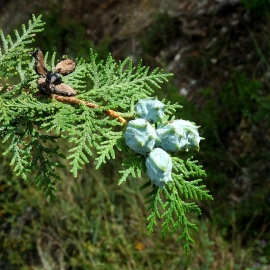





Organic Oriental Thuja Seeds (Platycladus)
1.14 €
Thuja orientalis a shrub or small tree, 15mt. tall, with a dense crown and thin, reddish brown bark, native of China, grown successfully in forests in Bihar. And frequently planted for ornament all over India, particularly in hill-stations.
-
Organic Oriental Thuja (Platycladus)
Thuja orientalis a shrub or small tree, 15mt. tall, with a dense crown and thin, reddish brown bark, native of China, grown successfully in forests in Bihar.
And frequently planted for ornament all over India, particularly in hill-stations. Leaves 3mm. long rhombic-ovate, acute; cones erect, globose-ovate; seedsvinged. It is extensively cultivated as an ornamental tree in cool, moist places for its attractiveand dense foliage and bush like habit of growth. It is also grown as a hedge-plant, and for screens. The trees make fine avenues in gardens and parks. It is propagated by cuttings and seeds. The better-quality seeds are those which sink after not more than eight-hour of soaking. It is popular as a Christmas-tree in the plains.
How to Grow
Chinese Arborvitae seeds are relatively easy to germinate and grow. The dormancy within the seed is short and easily broken. This is achieved by a short period of cold stratification in the fridge. First soak the seeds in water for 24 hours.
Next fully drain away all of the water and place the seeds in a zip-lock freezer bag. Place the seeds in the fridge, it is important that during this period that the seeds do not dry out or are waterlogged otherwise the pre-treatment will be ineffective.
After 8 weeks under these conditions the seeds are ready to be sown. In general, many seeds will fail to germinate unless treated in this way, simply sowing untreated seeds in compost at room temperature will not break down the dormancy and germination will be disappointing.
Fill your chosen container with a good quality general potting compost. Suitable containers could be plant pots, seed trays or plug trays or even improvised containers with drainage holes. Firm the compost gently and sow the seeds on the surface. If you are sowing in plug trays, sow 2 or 3 seeds per cell.
Cover the seeds with a couple of millimeters of vermiculite or failing that a fine layer of sieved compost. Follow with a gentle watering and keep them at room temperature. Germination will begin a few weeks from sowing.
The seedlings are reasonably robust and trouble free and usually grow to a height of between 2 and 4 cm in the first growing season depending on the sowing date and cultural techniques. Developing seedlings should be fine in full sun, keep them well watered and free of competing weeds.
The seedlings first leaves resemble short needles, once the seedling has developed sufficiently and is perhaps between 3 and 5 cm tall it will begin to produce the flattened foliage fronds normally associated with this species.
Growth will accelerate in the second and subsequent years and the developing young trees should be re-potted as necessary preferably during the dormant season. After perhaps 2 or 3 years they are ready to be planted in their permanent position
